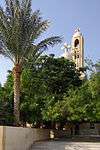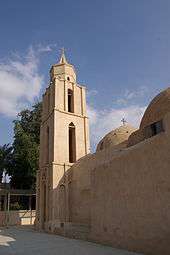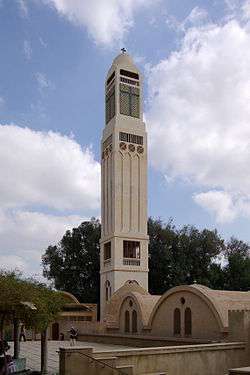Wadi El Natrun
| Wadi El Natrun | |
|---|---|
|
Monastery of the Syrians in Wadi el Natrun | |
 Wadi El Natrun Location in Egypt | |
| Coordinates: 30°35′N 30°20′E / 30.583°N 30.333°E | |
| Country |
|
| Governorate | Beheira |
| Time zone | EET (UTC+2) |
Wadi El Natrun (Arabic for "Natron Valley"; Coptic: Ϣⲓϩⲏⲧ Šihēt "Measure of the Hearts", Greek: Σκῆτις [1] or Σκήτη) is a valley located in Beheira Governorate, Egypt, including a town with the same name. The name refers to the presence of eight different lakes in the region that produce natron salt.
In Christian literature it is usually known as Scetis (or Skete; Σκήτις, Σκέτη in Ancient Greek) and is one of the three early Christian monastic centers located in the desert of the northwestern Nile Delta.[2] The other two monastic centers are Nitria and Kellia.[2] These three centers are often easily confused and sometimes referred to as a single place (such as "Nitria" or "Nitrian Desert"), but the locales are distinct, though geographically close together and with interrelated histories.[2] Scetis, now called Wadi El Natrun, is best known today because its ancient monasteries remain in use, unlike Nitria and Kellia which have only archaeological remains.[2]
The Nitrian Desert is sometimes used to mean the entire region where the monasteries are located. It can also more specifically refer to the immediate area around Nitria and Kellia, with the region around Wadi El Natrun then more specifically called the Scetis Desert. (The word Σκήτη has been adopted in Greek language monastic usage as an isolated monastic cell that is not in a convent, whereas Kellia (Κελλία (sing. Κελλίον from Latin 'cella') is a monastic cell in a convent.)
Fossil discoveries
The area is one of the best known sites containing large numbers of fossils of large pre-historic animals in Egypt, and was known for this in the first century AD and probably much earlier.[3]
History
The alkali lakes of the Natron Valley provided the Ancient Egyptians with the sodium bicarbonate used in mummification and in Egyptian faience, and later by the Romans as a flux for glass making.
The desolate region became one of Christianity's most sacred areas. The desert fathers and cenobitic monastic communities used the desert's solitude and privations to develop stoic self-discipline (asceticism). Hermit monks believed that desert life would teach them to eschew the things of this world and follow God's call. Between the 4th and 7th century A.D., hundreds of thousands of people from the world over joined the hundreds of Christian monasteries in the Nitrian Desert, centered on Nitria, Kellia and Scetis (Wadi El Natrun).
Saint Macarius of Egypt first came to Scetis (Wadi El Natrun) around 330 AD where he established a solitary monastic site.[4] His reputation attracted a loose band of anchorites, hermits and monks who settled nearby in individual cells. Many of them came from nearby Nitria and Kellia where they had previous experience in solitary desert living; thus the earliest cenobitic communities were a loose a consolidation of like-minded monks.[2] By the end of the fourth century, four distinct communities had developed: Baramus, Macarius, Bishoi and John Kolobos. At first these communities were groupings of cells centered on a communal church and facilities, but enclosed walls and watchtowers developed over time and in response to raids from desert nomads.[2] Nitria, Kellia, and Scellis also experienced internal fractures related to doctrinal disputes in Egypt.[2] The monasteries flourished during the Muslim conquest of Egypt (639-42), but in the eighth and ninth centuries taxation and administration concerns led to conflicts with the Muslim government.[2] Nitria and Kellia were eventually abandoned in the 7th and 9th centuries respectively, but Scetis continued throughout the Medieval period.[2] Although some of the individual monasteries were eventually abandoned or destroyed, four have remained in use to the present day:[2]
Saints of the region
Some of the most renowned saints of the region include the various Desert Fathers, as well as Saint Amun, Saint Arsenius, Saint John the Dwarf, Saint Macarius of Egypt, Saint Macarius of Alexandria, Saint Moses the Black, Saint Pishoy, Sts. Maximos and Domatios, Saint Poimen The Great and Saint Samuel the Confessor.
Saint-Exupéry
The environs of Wadi Natrun have been identified as the likely site of where the plane of French aviator Antoine de Saint-Exupéry crashed on December 30, 1935. After miraculously surviving the crash, he and his plane's mechanic nearly died of thirst before being rescued by a nomad. Saint-Exupéry documented his experience in his book "Wind, Sand and Stars",[5] and is thought to have inspired his masterpiece, "The Little Prince".
Image gallery
See also
References
- ↑ WĀDĪ NAṬRŪN in: Oxford Dictionary of Byzantium
- 1 2 3 4 5 6 7 8 9 10 Roger S. Bagnall, etc. Egypt from Alexander to the early Christians: An Archaeological and Historical Guide, Getty Publications, 2004. pg. 108-112
- ↑ Adrienne Mayor, The First Fossil Hunters - Paleontology in the Greek and Roman Times, 2000.
- ↑ "The first monk to settle in Wadi Natrun was Macarius the Egyptian, whose retirement to the desert took place in 330 A.D.." (Hugh G. Evelyn-White, "The Egyptian Expedition 1916-1919: IV. The Monasteries of the Wadi Natrun" The Metropolitan Museum of Art Bulletin, 15.7, Part 2: The Egyptian Expedition 1916-1919 [July 1920):34-39] p 34; Evelyn White's article gives a brief overview of Wadi Natrun from literary sources.
- ↑ Saint-Exupéry, A. de. 1939. Terre des hommes (English title: Wind, Sand and Stars). Paris.
Further reading
- M. Cappozzo, I monasteri del deserto di Scete, Todi 2009 (Tau Editore).
External links
| Wikimedia Commons has media related to Wadi El Natrun. |
- The monasteries of the Arab Desert and Wadi Natrun UNESCO World Heritage Centre 1992-2012
Coordinates: 30°25′55″N 30°14′49″E / 30.43195°N 30.246878°E






